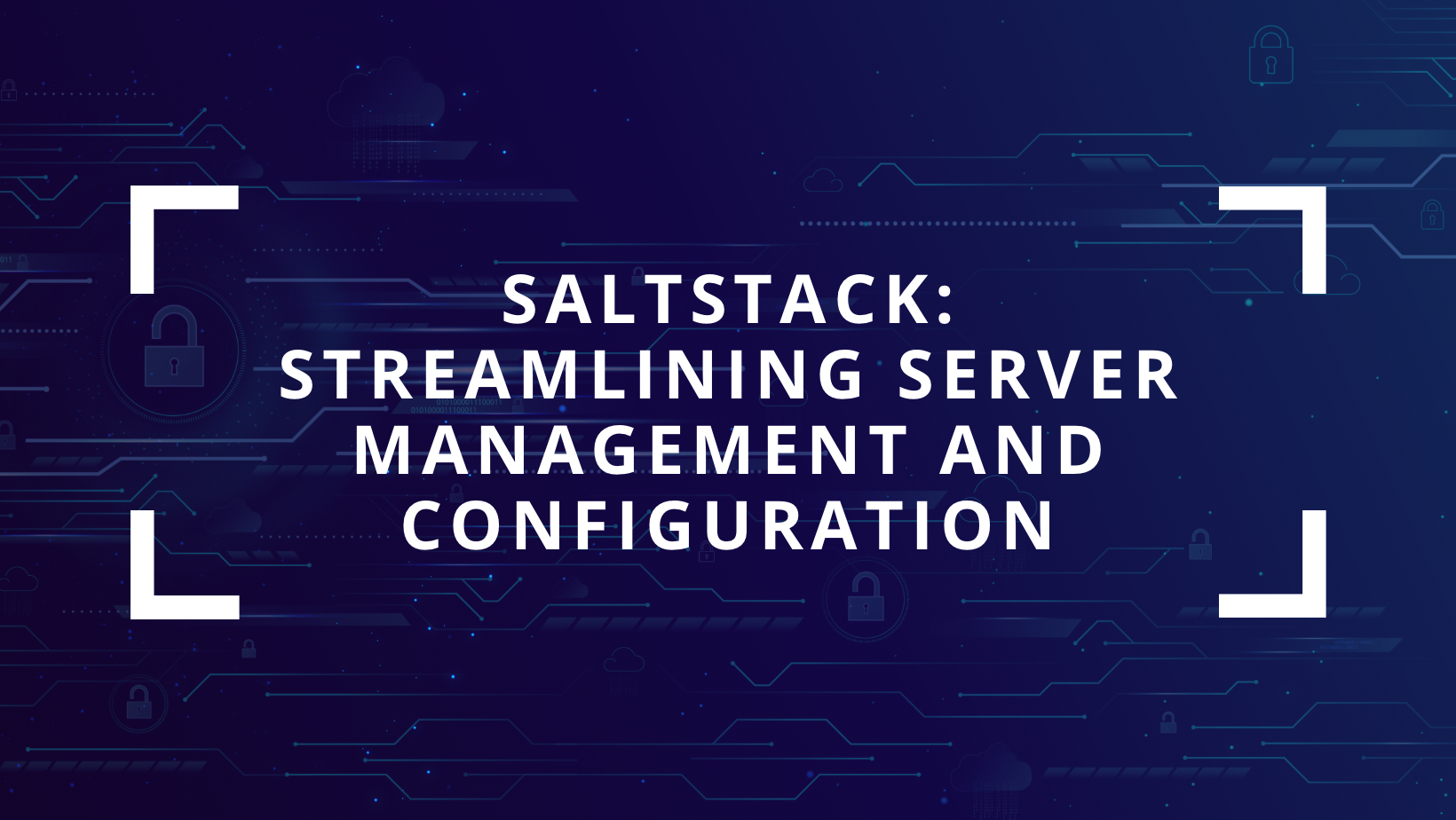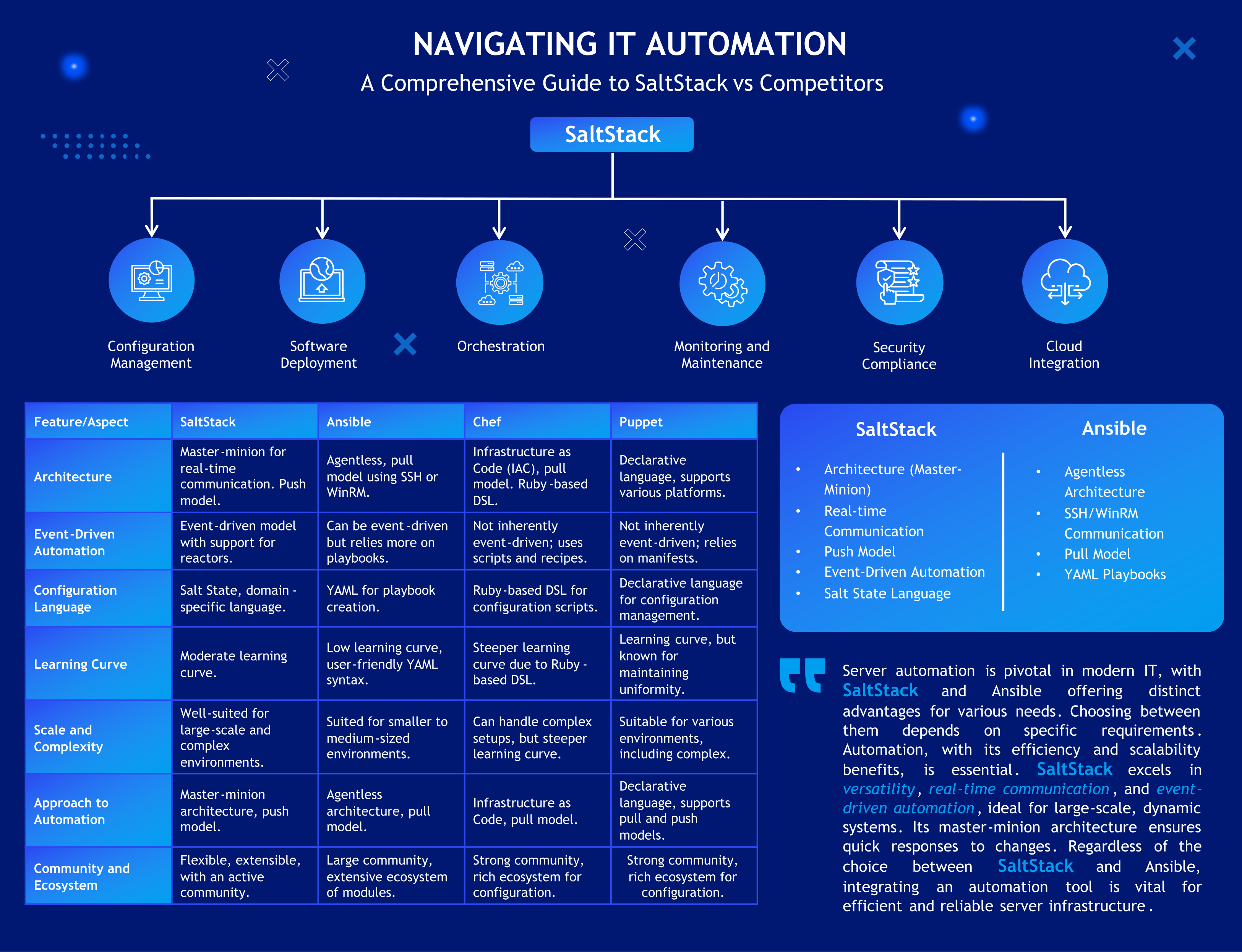
The ever-evolving landscape of Information Technology (IT) infrastructure management has driven the need for robust automation and configuration tools. In this era, where the complexity and scale of server environments continue to expand, it’s essential to employ automation solutions that simplify tasks, enhance efficiency, and ensure the uniformity of configurations across a diverse range of servers. SaltStack, often referred to as Salt, stands as a powerful, adaptable, and open-source solution, enabling system administrators to automate server configuration, orchestration, and maintenance with remarkable ease.
In this article, we embark on a comprehensive exploration of SaltStack, shedding light on its use cases, competitors, basic instructions with real-world examples, and a comparative analysis against Ansible. By the end of this journey, you’ll be well-equipped to make informed decisions about integrating SaltStack into your automation strategy, ensuring the effective management of both on-premises and cloud environments.
Use Cases
SaltStack’s versatile nature endows it with a wide range of use cases, making it a preferred choice for managing servers across a spectrum of environments, from on-premises data centers to cloud infrastructures. Let’s delve into some of its fundamental applications:
Configuration Management: SaltStack allows you to define, apply, and enforce configurations across your server fleet, ensuring uniformity and reducing the likelihood of human errors. You can create and enforce standards for software installations, system settings, and security configurations.
Software Deployment: Automate the deployment of applications and updates, guaranteeing that the latest software is consistently installed on all target systems. This ensures that your applications remain up-to-date without manual intervention.
Orchestration: Streamline complex workflows by orchestrating multiple tasks across servers. This can include scaling resources during traffic spikes, coordinating failover procedures, and managing the setup and teardown of complex environments.
Monitoring and Maintenance: Use SaltStack to monitor server health and automate maintenance tasks like backups, log rotation, and system updates. This proactive approach helps in identifying and addressing issues before they impact your services.
Security Compliance: Enforce security policies and ensure that servers are compliant with regulatory standards through automated security checks and remediation. SaltStack can continuously scan and remediate security vulnerabilities to maintain a secure infrastructure.
Cloud Integration: SaltStack seamlessly integrates with various cloud platforms, enabling automation and orchestration of cloud resources alongside on-premises infrastructure. This flexibility allows you to create hybrid and multi-cloud environments while maintaining a single automation platform.
SaltStack’s flexibility and extensibility ensure that it remains a reliable choice for IT professionals looking to manage their server infrastructure more efficiently, regardless of the environment in which they operate.
Competitors
While SaltStack excels in many areas, it’s imperative to understand its competitors and alternatives to make an informed choice that aligns with your specific requirements. Here are some notable competitors:
Ansible: Ansible, another open-source automation tool, is celebrated for its simplicity and agentless architecture. It employs a declarative language for configuration management and orchestration, making it an excellent alternative to SaltStack, particularly for smaller-scale setups and more straightforward configurations. Ansible is known for its low learning curve, making it a popular choice for quick deployments and simple automation tasks.
Chef: Chef centers its approach on Infrastructure as Code (IAC) and employs a Ruby-based DSL for creating configuration scripts. It offers a high level of flexibility but has a steeper learning curve when compared to SaltStack. Chef is often chosen for its ability to express infrastructure as code and manage it effectively.
Puppet: Puppet is a robust configuration management tool that excels in automating repetitive tasks and maintaining infrastructure uniformity. It utilizes a declarative language and supports various platforms, including Windows, Linux, and macOS. Puppet’s rich ecosystem of modules and strong community make it a powerful choice for configuration management.
SaltStack vs. Ansible: A Comparative Analysis

SaltStack and Ansible are two prominent automation tools, each with its unique strengths and characteristics. Let’s delve deeper into a comparative analysis of these two solutions:
SaltStack
Utilizes a master-minion architecture, facilitating real-time communication and updates between the Salt Master and Minions. This architecture allows for instant changes and reactions to infrastructure events.
Operates using a push model, making it highly suitable for orchestration and real-time reactions to infrastructure changes. Changes can be pushed from the Salt Master to the Minions as needed.
Employs an event-driven model and supports event reactors, which can trigger actions based on system events. This feature allows for automation that responds to real-time changes in the environment.
Employs a domain-specific language known as Salt State for configuration management, offering deep flexibility and customization. This allows for fine-grained control over system configurations.
Well-suited for large-scale and complex environments due to its real-time capabilities and extensibility. SaltStack can effectively manage diverse and intricate infrastructure.
Ansible
Features an agentless architecture, which simplifies setup and reduces the overhead of agent management on target systems. Ansible relies on SSH or WinRM for communication, making it easy to set up and use.
Utilizes a pull model, where the control machine connects to target nodes and executes tasks based on playbooks. This architecture is ideal for systems where direct communication with target systems is feasible.
While Ansible can be event-driven through external triggers, it doesn’t natively support event-driven automation as comprehensively as SaltStack. Ansible primarily relies on playbooks to define tasks and configurations.
Employs YAML for playbook creation, providing a human-readable and accessible way to define tasks and configurations. YAML is widely used and understood, making Ansible playbooks approachable.
Well-suited for smaller to medium-sized environments and simpler configurations due to its straightforward, agentless nature. Ansible excels at handling tasks and configurations that are less complex.
Conclusion
The automation and configuration of server environments have become critical components of modern IT operations. SaltStack and Ansible are both powerful tools that offer unique advantages for different use cases and organizational needs. The decision to choose one over the other ultimately depends on your specific requirements and the nuances of your existing infrastructure.
In conclusion, the benefits of automation, including enhanced efficiency, error reduction, and the ability to scale operations, are undeniable. SaltStack stands out as a versatile and robust solution, offering real-time communication, event-driven automation, and extensive flexibility for large-scale environments. Its master-minion architecture allows for quick, real-time responses to infrastructure changes, making it an excellent choice for organizations managing complex and dynamic systems.
The choice between SaltStack and Ansible should be guided by a careful evaluation of your environment, goals, and available resources. Regardless of your selection, integrating an automation and configuration tool into your IT operations is a crucial step toward achieving greater efficiency and ensuring the consistency and reliability of your server infrastructure.
